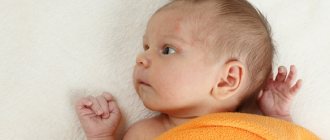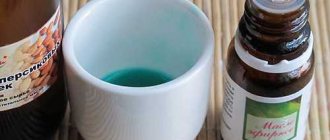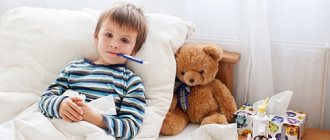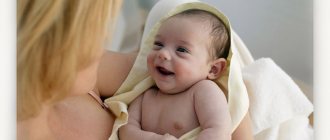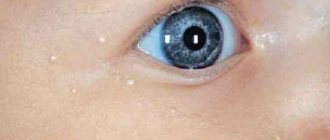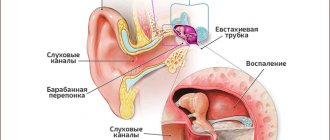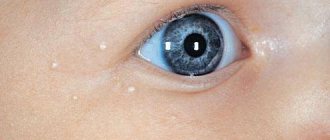Greetings, friends! In this article we will deal with a rather simple issue that concerns the health of your child. We will consider the reasons for the appearance of irritation on the chin of a baby. The phenomenon is quite common, many mothers do not pay attention to it, but most still worry whether this is a symptom of some serious illness.
I would also like to draw your attention to the fact that the article will focus specifically on pimples that pop up on the chin and around the mouth. We will not take the face as a whole, because the causes and methods of treatment will be completely different. Therefore, we consider the chin.
Causes of irritation
Before we talk about the causes, let's first find out what type of rash is. These are usually small red pimples; a little less often there may be red ones with a white dot, a rod in the middle. There are two reasons for the appearance of such pimples: drool and allergies.
There are also pure white pimples, which are associated specifically with hormones and are observed in infants at a very early age, in the first months after birth. Such acne goes away very quickly with age and does not require any intervention. But they can pop up not only on the chin, but also on the face as a whole. But you and I agreed to look only at the chin.
Drooling
In the first year of life, a child produces quite a lot of saliva. First, this happens because the salivary glands begin to test their work, then because the baby begins to cut teeth. Another reason may be that the child, out of curiosity, puts everything into his mouth along with bacteria, and, as you know, the more microbes in the mouth, the more saliva is produced.
I described all this in more detail in the articles:
Quite often, red pimples on a baby’s chin coincide with the eruption of the first teeth. During this period, a lot of saliva begins to be released, and in children it is quite “caustic” and irritates delicate skin. Parents still don’t know what to do with this saliva, so we end up with small pimples.
Why on the chin? Yes, because drool flows down just down the chin and, if you don’t wipe it off in time, it can cause irritation.
In addition to teeth, the cause may also be the pacifier, which the baby has begun to actively use. The pacifier could also become a source of bacteria in the mouth and, accordingly, excessive salivation. You can read more detailed information regarding pacifiers:
Allergy
In fact, allergic reactions occur in children not only on the chin, but also on the face as a whole. If it is an allergy to some product, then it is mainly the cheeks that suffer. “Why are the child’s cheeks red?” Therefore, you should not make hasty conclusions regarding new products.
There is one nuance here: the food had an external effect on the child’s chin. After all, as you know, babies eat very sloppily, especially if you have just started introducing complementary foods. Remains of some liquid puree may flow down the chin, which causes irritation.
Also, an allergy could not necessarily arise from food. Perhaps it's the clothes. Think about whether your child has a new jacket or sweater that he could use to rub his chin. This could be either an allergy to a given item, or simply a banal irritation that arose due to friction.
A one-year-old child has pimples on his face
It has long been known that beauty and health are interconnected. Skin is an indicator of the body's well-being. If it is smooth and velvety, then the person is healthy.
Various rashes and changes in the color of the skin indicate malfunction of any of the body systems. In this case, treatment is not always required - sometimes lifestyle changes are enough.
What to do if you find a rash?
There are a lot of diseases that are accompanied by a rash. In order to distinguish them, you need to take into account the nature of the rash: color, size, dynamics of manifestation. The accompanying symptoms cannot be ignored. All rashes can be classified into 2 groups:
The table shows the most common primary rashes:
RESULTS µÑ‚ей разного воз CONDITIONS
As already noted, the rash can be primary or secondary. Primary rashes are of greatest interest because they are the most common. It is with their diagnosis that difficulties arise. Based on shape and appearance, the following varieties are distinguished:
- Tubercles are non-hollow lumps on the skin.
- Blisters are dense areas that rise above the level of healthy skin. Blisters are an allergic reaction to poison from plants and insects.
- Papules, or nodules, are non-hollow elements that differ in height and color from healthy skin. They usually go away on their own.
- Bubbles are small pimples. They have a pronounced center filled with cloudy liquid.
- Bubbles are large formations (from 0.5 cm).
- Pustules are pimples filled with pus.
- Spots are changes in the color of the skin.
- Roseola are small pink or red spots that disappear when you apply pressure to the affected area.
Roseola nursery
Red rash
Acne can also appear in a child due to poor hygiene. If the baby is covered with bright pimples, then this is a skin reaction to pollution, to which children are especially susceptible in the first 6 years of life. To prevent your child from becoming covered with a painful crust on delicate areas of the skin, carefully monitor the baby’s cleanliness and accustom him to water procedures.
A consequence of unfavorable thermal effects is hyperhidrosis, or prickly heat. It manifests itself most clearly in infants, starting at one month of age.
The baby’s body has not learned to adapt to the ambient temperature, so spots appear on his head and shoulders from sweat.
All treatment comes down to frequent exposure of the little patient to the fresh air and regular ventilation of the premises.
Red spots on the forehead, cheeks and shoulders are often a sign of allergies. During lactation, this means that the mother should adjust her diet and also abandon aggressive household chemicals.
Allergic rashes
Red pimples in a child are also observed with toxic erythema. The rash occurs in the facial area: on the head, forehead, cheeks, nose. Newborns and babies under one year of age are most susceptible to it.
This type of rash does not require specific treatment and disappears on its own within 7-8 days.
At a later age, erythema is rare and, as a rule, is a consequence of uncomfortable living conditions: humidity, ambient temperature.
As mentioned above, red rashes can be infectious in nature and observed in the following diseases:
- measles;
- rubella;
- scarlet fever;
- chickenpox.
Chicken pox rash
The most dangerous possible cause of skin changes is meningitis. The disease is severe and in some cases is fatal. A characteristic feature of the infection is a rapid increase in body temperature and the gradual spread of an itchy rash throughout the body. If you have the slightest suspicion of meningococcal infection, you should immediately consult a doctor.
White pimples
Milia, or white pimples, are a type of acne that occurs in adolescents during hormonal changes. They are a small cyst formed as a result of excess sebum. Appear on the cheeks, nose, forehead.
The causes of milia are varied: poor diet, poor-quality cosmetics, hormonal imbalance. As a rule, rashes disappear on their own with age (at 15-16 years of age).
If not, you should visit a dermatologist or endocrinologist.
The predominant localization of milia is the area around the eyes, cheekbones, and T-zone (forehead-nose-chin). It is impossible to squeeze out such a tubercle - the source is deep under the skin. To get rid of white pimples on the face, you need to adjust your diet and provide quality skin care by choosing products that correct the functioning of the sebaceous glands.
Similar rashes also occur in newborns and go away on their own within 1-2 months of life.
Milia in a newborn
Colorless rashes
Small colorless rashes that resemble nodules are called neonatal acne. Neonatal cephalic pustulosis appears on the face of children during the first month of life.
This is how the baby’s skin reacts to the remnants of maternal hormones. No specific treatment is required - the baby will soon adapt to new living conditions.
Acne usually goes away on its own within a few days, weeks or 1 year.
Colorless or flesh-colored watery pimples on the cheeks in later life may indicate a malfunction in the immune system: this is how a food allergy or reaction to emotional stress manifests itself. This phenomenon is called dyshidrosis. In emotionally stable children, it goes away on its own; otherwise, therapy is required, including the use of weak sedatives.
Minor rash
If the fever is accompanied by low-grade body temperature (from 37.0 to 37.5 °C), allergic hyperemia, a systemic disorder or a sluggish infection occurs. In the presence of dermatological diseases (pyoderma, erythema, urticaria), body temperature may not increase.
Large purulent blisters
The appearance of purulent blisters can be caused by various factors:
- hormonal disorders;
- compaction of the apex of the epidermis - hyperkeratosis;
- improper skin care;
- abuse of low-quality decorative cosmetics;
- frequent stress;
- unbalanced diet;
- disorders of the gastrointestinal tract.
Other types of rashes
Almost every person is familiar with acne on the face firsthand. They can appear at any age and significantly spoil plans.
Children with immature immunity and during the period of hormonal changes are most prone to the appearance of acne and rashes (see also: photos of rashes and other manifestations of measles in children).
In most cases, acne on a child’s face is normal, but sometimes a rash is a sign of dangerous pathologies.
If the symptoms are not similar to any of the cases described above, you should pay attention to the table with explanations of other types of rashes.
| Type of rash | Description | Possible diagnoses |
| Ulcer | A deep defect of the skin and mucous membranes with the obligatory formation of a scar. | Diabetes, anemia, cancer, aerobic infections. |
| Crust | The dried contents of pustules, blisters or ulcers. | Herpes, eczema, diathesis. |
| Flake | Loosened horn cells. The skin is severely peeling at the affected area. Often localized on the head. | Ichthyosis, fungal infection, tinea versicolor. |
| Lichenization | Thickening, compaction, dry skin, pigmentation. The skin pattern is clearly visible. | Lichenification. |
Source: https://dou99.ru/poleznaya-informatsiya/na-litse-u-godovalogo-rebenka-pryshhiki
What to do in such cases
First you must clearly determine the reason. If you decide that this is drool, it means:
If you see that there is not so much drooling, then perhaps the reason lies elsewhere. Analyze what new food you gave your child. Perhaps you have introduced a new ingredient into complementary foods. If you remember about a new product, then try to temporarily exclude it from your diet and see the reaction.
Also, after each spoon feeding (if your baby eats sloppily and splashes everything), it is advisable to wash the child so that traces of food do not remain on the face and, in particular, on the chin.
If you maintain hygiene and begin to wash your baby more often, plus you have eliminated several foods from the diet that could cause allergies, but the pimples still do not go away and the child is capricious because of them, then you can do the following.
- Buy chamomile or chamomile in bags and brew according to the instructions.
- Use cotton pads to wipe your baby's face several times a day.
- Try wiping in turns: one day with chamomile, and the second in succession. Look at the result. Both decoctions should relieve irritation quite well.
That’s basically all, we have figured out the main reasons for the appearance of a rash on the chin of an infant and found out how to help the baby in such cases.
Acne on a child's face is a common occurrence, but it is always a cause of concern for adults. Children's immunity adapts to the environment, and the result of its adaptation may be the appearance of acne on the child's face.
The reasons for the presence of rashes can be completely harmless or pose a real threat, which is why it is necessary to be able to identify the danger in time and take action.
Pimple on the face of a one-year-old child – All about Health
Pimples on a child's face can be a sign of infection.
Therefore, even if the rash does not cause discomfort in the baby, the problem cannot be ignored.
Children's acne can occur not only due to infectious diseases - there are many reasons for their appearance.
- All information on the site is for informational purposes only and is NOT a guide to action!
- can give you an ACCURATE DIAGNOSIS !
- We kindly ask you NOT to self-medicate, but to make an appointment with a specialist !
- Health to you and your loved ones!
The appearance and location of the rash, as well as the age of the child, help determine the underlying cause.
After all, at every stage of life, acne may appear that is not typical for other ages.
Causes
The appearance of a rash on the body and face of a small child can be caused by a variety of reasons.
- Teething. The rash is localized around the mouth, and its appearance is caused by increased salivation and irritation of the skin with saliva. As soon as the eruption process is completed, the acne goes away.
- Milliaria (prickly heat). Small rashes in an infant that appear during the hot season may be a manifestation of common heat rash.
- Allergy. The development of an allergic reaction is accompanied by the appearance of large and small red pimples on the skin. The rash appears suddenly and is accompanied by itching.
- Vaccine. Sometimes a rash appears after vaccination. If a reaction to vaccination develops, your baby should be immediately shown to a pediatrician.
- Adverse environmental influences. Active solar radiation, frost and wind negatively affect sensitive children's skin and can cause acne.
- Insufficient care. The extremely delicate and sensitive skin of a small child requires careful care. Contamination of the skin can lead to the appearance of pustular rashes.
inflamed rashes after mosquito bites
- Insect bites. In some children, inflamed red pimples appear after insect bites. This rash is scattered unevenly over the body and causes severe itching. Insect bites are especially dangerous in countries with hot and humid climates - they can provoke not only an allergic reaction, but also infection with the subsequent formation of painful purulent pimples.
- Acne of newborns. A rash in a newborn appears due to increased levels of hormones transmitted from the mother.
- Dyshidrosis. Pimples appear only on the palms and feet during the off-season (autumn, spring).
- Intestinal dysbiosis. Most often diagnosed in babies 7 months old, it manifests itself as a small rash on the cheeks and scalp, accompanied by severe itching.
acne during puberty
- Puberty. The formation of acne in adolescents is due to changes in hormonal balance (an increase in the level of male sex hormones occurs in both boys and girls). Such rashes go away on their own after hormonal levels stabilize. During this period, it is important to teach your child proper skin care, otherwise rashes on the face can become a constant problem.
Other common causes of childhood acne are various infectious diseases.
- Streptoderma. A skin disease caused by bacteria of the streptococcus group. The appearance of acne may vary depending on the form of streptoderma. More often, the rashes look like red pimples with watery contents inside.
- Vesiculopustulosis. Skin disease caused by staphylococcal infection. Inflammation of the skin is accompanied by the appearance of white purulent pimples on various parts of the body and requires immediate consultation with a doctor.
- Folliculitis. Skin lesions of a viral or bacterial nature. It is more common in children living in countries with hot climates. The causative agent of the disease can be staphylococcus, less often - fungi and parasites. Painful pimples with purulent contents are localized in places where there is a large accumulation of hair follicles (usually on the head).
- Chicken pox. Infection caused by the herpes virus. Chickenpox rashes are small, filled with liquid, scattered over all parts of the body and mucous membranes, and cause severe itching. Gradually the blisters burst and ulcers appear in their place. Common symptoms of infection are fever and headache.
- Scarlet fever. The disease causes the appearance of profuse, pinpoint rashes throughout the body. Pimples cover the face (except for the area of the nasolabial triangle) and body, and on the folds (under the knees, under the arms, in the groin) they are grouped into red stripes. With scarlet fever, the rashes are very itchy, the mucous membranes and tonsils become inflamed, and the temperature rises.
- Measles. The rash appears 4–5 days after the onset of the acute infectious process. Red spots and blisters affect the face and scalp, then spread to the trunk and limbs. The disappearance of the rash occurs in the reverse order.
- Rubella. It manifests itself as a rapid spread of small pink pimples throughout the body, inflammation of the cervical and occipital lymph nodes.
rubella rash
Diabetes mellitus can also cause rashes in a child.
Acne that occurs due to high sugar content in urine is usually localized on the butt and genital area.
What are there
You can guess why acne appeared on your baby's skin by their appearance. However, to clarify the diagnosis, you will need to consult a doctor.
Source: https://womaninred.ru/pryshh-na-lice-u-godovalogo-rebenka/
Causes of the rash
The appearance of pimples in a child is associated with various factors. It may also be accompanied by various symptoms, which may indicate the presence of certain problems in the body. The most important thing is to detect the change in time and begin treatment.
Of course, there are situations when treatment is not required, but it is definitely difficult to independently identify the cause. In order to determine the diagnosis, you should consult a good specialist.
All the causes of acne can be reduced to several factors:
- unformed hormones (hormonal background);
- increased secretion of the sebaceous glands;
- presence of viruses or infections;
- lack of hygiene or improper maintenance.
The color of the rash, location, as well as the nature, accompanying symptoms and age of children determine different types of rashes. Thus, in newborns, during the formation of hormonal levels, white pimples may appear on the face, which go away on their own and do not require treatment.
White pimples on the face of an older child are evidence of acne disease, for which appropriate therapy should be carried out.
Acne on a child's face
If redness on the skin and pimples on the child’s face do not go away for a long time, it is better to show the baby to the pediatrician, because at first glance, harmless pimples may indicate the progression of a dangerous pathology in the body, which is important to diagnose and begin to treat in a timely manner. Even a 6-month-old baby can develop a rash on the delicate skin. If parents do not know its nature, self-medication is contraindicated.
Main causes
Most often, small pimples on a child’s forehead, chin or nose do not pose any threat to health and disappear on their own after normalizing nutrition and observing personal hygiene rules.
In children under one year of age, a rash on the face can form as a result of the influence of an allergic, hereditary or infectious factor.
Subcutaneous white pimples in a newborn often indicate endocrine disorders, which are a consequence of the hormonal crisis of newborns.
A rash on the face at the age of 9-12 may indicate hormonal changes, viral infection, parasitic infestation, or malfunction of the gastrointestinal tract.
What types of rashes are there?
In a small child, pimples are classified according to different criteria. Considering the shape and filling, the following varieties are distinguished:
- tubercles;
- pink or red spots;
- blisters;
- papules;
- colorless bubbles;
- ulcers.
Depending on the color, the following types of acne on the face in young children are distinguished:
- The correct diagnosis will be made by a pediatrician. Reds. Many rashes not only on the skin of the face, but throughout the body may indicate the infectious nature of the rash and the progression of measles, rubella, scarlet fever, and chickenpox in the body. And also red pimples on the body often occur under the influence of an allergic factor. Failure to comply with personal hygiene rules and poor diet are also the reasons why dry acne appears.
- White. Small pimples on the forehead and acne on the nose in a teenager indicate hormonal changes. A white rash on the face can also be a consequence of poor nutrition, the use of low-quality cosmetics, and dysfunction of the sebaceous glands.
- Transparent pimples. In newborns, such rashes occur under the influence of a hormonal factor on the body. If such pimples appear on the nose, forehead and chin, it is better to show the baby to the pediatrician, but often this condition is not dangerous and does not require treatment.
- Small pimples. A one-year-old child may have symptoms of an allergic reaction, viral infection and progression of dermatological diseases such as erythema, urticaria, pyoderma.
- Purulent. A large pimple with purulent contents in boys or girls aged 7 years may indicate improper facial skin care, non-compliance with nutritional rules, abuse of low-quality decorative or skincare cosmetics, and disruption of the functioning of the gastrointestinal tract.
Features in newborns
If acne appears in a child in the first 2-3 months of life, then this is most likely a consequence of hormonal changes, which are typical for some babies immediately after birth.
Hormonal imbalance in the body occurs due to an excess of maternal hormones in the baby’s blood. Such pimples do not hurt, do not itch and do not cause discomfort.
They go away on their own without requiring treatment.
Children's pimples can also have an infectious etiology, causing the following diseases:
- epidemic pemphigus;
- toxic erythema;
- prickly heat.
Other symptoms
Acne in children may be accompanied by fever.
If acne on the face of a 3-year-old child occurs due to insufficient skin hygiene or the use of low-quality cosmetics, then there will be no pronounced symptoms. Sometimes itching, redness and discomfort may occur. When childhood pimples occur as a result of internal disorders, the following symptoms may appear:
- increased body temperature;
- cough, sneezing, runny nose, increased lacrimation;
- swelling of the mucous membrane;
- burning, itching and peeling of the skin;
- enlarged lymph nodes;
- general malaise;
- headache.
Diagnostic methods
If red or white acne on the face of children does not go away for a long time and also causes a lot of discomfort, it is better to show the baby to a pediatric dermatologist. After an initial examination, palpation and history taking, the doctor will prescribe a dermatoscopy. Sometimes, to clarify the diagnosis, you will need to submit samples for pH testing and bacteriological examination.
Drugs
If the rash occurs as a result of the progression of any internal pathology in the body, first of all, therapy is prescribed to eliminate the cause of acne. For children, the treatment regimen is selected individually and often includes the following groups of drugs:
- antiviral;
- antimicrobial;
- antihistamines;
- antiseptics;
- vitamins, immunostimulants.
Desitin ointment performs well.
It is recommended to treat a flaky spot with Desitin and Bepanten ointments; soft baby creams, which should be prescribed by a doctor, also help to cope with rashes.
If a child is not yet 1 year old, but already has rashes, it is forbidden to lubricate the pimples with iodine, brilliant green, or peroxide at your own discretion, as this can only worsen the situation. Sometimes drug therapy alone cannot get rid of the problem.
Then the doctor will recommend laser cauterization, which increases the sensitivity of tissues to drug treatment, which will speed up recovery.
Physiotherapy
To eliminate acne, dermatologists often recommend that teenagers use physiotherapeutic procedures, the main purpose of which is to cleanse the skin, normalize blood circulation and tissue nutrition, and prevent the accumulation of subcutaneous fat in the pores. The following methods have proven themselves well:
- transsolvanization;
- FUV irradiation;
- ozone therapy;
- ultratonotherapy;
- magnetic therapy;
- ultraphonophoresis;
- paraffin and ozokerite applications;
- Thalassotherapy;
- electrophoresis;
- franklinization;
- UHF.
Folk remedies
Non-traditional methods also help to effectively combat pimples of various etiologies in children, but before using such remedies you should consult a doctor, which will help avoid dangerous consequences. If a cold pimple appears on your forehead, nose or chin, it is recommended to prepare a bactericidal infusion that will help get rid of inflammation faster. The recipe is:
- Cold pimples can be treated with herbal infusions.
Mix chamomile, sage and string in equal proportions. - Separate 1 tbsp from the mixture. l. and pour all 250 ml of boiling water.
- Let the product sit for 20 minutes, then strain.
- Soak gauze or a cotton pad in the prepared infusion and apply to the inflamed area for half an hour.
- Apply the compress 2-3 times a day, within a day the pimple will shrink in size and stop hurting.
Antiseptic herbal infusion is recommended to be added to bathing water. Regular use of the product helps reduce the amount of rash, relieve itching, burning, peeling and inflammation. The natural medicine is safe even for newborns, and it is no less effective for older children.
Prevention
In order for a child of any age to be bothered by acne as little as possible, it is recommended first of all to improve nutrition, teach how to observe personal hygiene rules, buy only high-quality children's cosmetics, and increase the body's protective functions.
To avoid complications, any suspicious pimple should not be lubricated with brilliant green, iodine or other aggressive liquids. It is better to show the child to a pediatric dermatologist, who, if necessary, will select the correct and safe treatment.
Source: https://StopRodinkam.ru/pr/lc/pryshhiki-na-lice-u-rebenka.html
Main types of rashes in children of different ages
There are two main types of rashes: infectious and non-infectious. Non-infectious acne in children of different ages comes in the form of:
- prickly heat (small red pimples, sometimes with liquid inside);
- hormonal acne (when adjusting the functioning of hormones);
- white dots (appear when the sebaceous glands normalize);
- allergic reactions (itchy red spots);
- pustules (small pimples with pus inside - the result of inflammation).
A child has acne on his face: types of rashes and methods of treatment
The appearance of pimples is one of the body’s ways to adapt to various changes. They can occur in children of any age. Parents should be able to determine the type of acne that appears, as well as the reason that contributed to its formation. This will help treat annoying rashes and also prevent them from occurring in the future.
Why do children get acne?
There are a huge number of reasons why acne appears on a child’s face. They may be related to the following processes:
- Allergic reaction.
- Intestinal dysbiosis.
- The baby will overheat.
- Viral disease.
- Improper hygiene.
- Hormonal imbalance.
- Increased sebaceousness of the skin glands.
Each of these reasons deserves a mandatory consultation with a doctor. This is the only way to prevent further rashes and alleviate the baby’s condition.
Non-infectious acne in children of different ages
Regardless of age, doctors distinguish between infectious and non-infectious types of acne. The first category includes the following rashes:
- Prickly heat.
- Hormonal acne.
- White dots.
- Allergic reaction.
- Pustules.
In most cases, acne on a child’s face does not indicate serious health problems. The most harmless rashes on this list include white pimples and hormonal acne. Other types of non-infectious rashes should be checked by a doctor to determine further treatment.
These types of acne belong to the category of dangerous rashes. They are the main symptom of a viral infection in the body. Most often they appear when:
- Herpes. The rash is red and itchy. Very similar to small bubbles.
- Folliculitis. Pimples contain pus, hurt and can burst.
- Scarlet fever. The disease manifests itself as itchy and dry small pimples.
- Rubella. Pimples are pink in color and quickly spread throughout the body.
- Streptodermatitis. The rash has a distinct red outline.
Infectious acne on a child's face requires treatment, as does the disease itself that caused it. Therapy is carried out using medications, ointments, gels and creams to heal the skin.
How to treat infectious acne on the face
When a child suffers from a viral disease, acne may appear on his face, which is considered one of the signs of a particular illness. Some diseases show their first symptoms in the form of rashes on the face. In this case, parents should go to the hospital in time and diagnose the infection in the baby’s body.
Next, doctors take care of his appropriate treatment. Therapy is most often carried out using antibiotics and other serious drugs.
Acne on a child's face always goes away along with the infection during the recovery period. Therefore, it makes no sense to treat them separately, because they are only a consequence of the disease.
However, during the treatment period it is necessary to ensure that the child adheres to the following recommendations:
- Pimples should not be squeezed, scratched or picked off. Otherwise, after recovery, scars will remain on your face and body.
- In order not to damage the wounds, you need to put special soft mittens on your child’s hands every night, which will prevent pimples from being ripped off the face.
- Treat rashes with a bactericidal solution every day.
If you follow these rules, your child’s recovery will be much easier.
Acne in babies
After birth, the child’s body has to adapt in every possible way to environmental conditions. He begins to live and develop separately from the mother's womb. Because of this new condition, his internal organs and skin begin to work even more actively. Therefore, many parents often encounter such a nuisance as acne in children.
In infancy, the child's rashes are white and red. The most harmless are small white pimples of a hormonal nature.
They appear in the baby immediately after birth and can bother parents for a short period of time. The rashes are localized on the forehead, eyelids, under the eyes, and also on the cheeks. Pimples of this type closely resemble small white bumps.
They don't hurt and rarely itch. Therefore, parents manage to quickly rid their baby of them.
Red pimples on a child's face are not always considered a harmless symptom. Such rashes can be caused by an inflammatory process in the body, which is caused by infection with microbes or viruses.
They are also the result of improper hygienic care of the baby and failure to maintain a comfortable temperature in the room.
Regardless of the cause of red pimples on the face of a child, you should immediately seek advice from a pediatrician.
Types of acne in babies
During the first year of life, many children develop rashes on the skin of the face and body. They are mostly white or red. To determine the cause of their appearance, it is necessary to be able to distinguish between all types of acne, which most often appear in infants.
Milia are white and small pimples on the baby's face that do not cause him concern. If such acne appears on the face of a month-old baby, there is no need to worry. This type of rash is only a consequence of the normal functioning of hormones. They do not require treatment and go away on their own.
Infant acne is small purulent pimples that appear under the influence of the mother's female hormones. They should not be a cause for concern, but if the rashes persist, it is better to consult a doctor.
Miliaria is a very common occurrence in infants, which is manifested by redness of the skin in the neck and armpits. Such a deviation often occurs after non-compliance with the temperature regime indoors or outdoors.
Another type of most common rash in infants is allergic pimples. They can form from poor nutrition of the mother, inappropriate children's cosmetics, as well as from washing powder with an aggressive composition. If your baby is one month old, and acne on the face causes severe concern, it is better to consult a doctor.
Treatment of acne in babies
Depending on the type of acne, your doctor may prescribe the following treatment methods:
- Bepanten cream or powder from the same company. This is how diaper rash and prickly heat are treated.
- Baths with the addition of herbal infusions: sage, calendula, chamomile, string herbs, etc. With the help of medicinal herbs, you can remove white pimples on a child’s face, as well as remove all redness.
- For allergic rashes, a nursing mother is prescribed a strict diet. If your baby is fed artificial formula, it is necessary to reconsider his diet.
- Acne on a child’s body can be wiped with Furacilin.
- Some rashes will need to be treated with antihistamines.
- If you have chickenpox, you will be prescribed to treat the skin with regular brilliant green.
Every parent should remember that if a child has acne on his face, self-medication is dangerous. Especially when it comes to his health. Even the smallest red bumps on a baby's body should make adults see a doctor. Only he can prescribe the treatment the child needs.
To prevent the development of rashes, it is necessary to promptly determine the causes of acne on a child’s face, provide good skin care, and also not neglect visiting doctors. Any self-medication can harm the baby’s health.
Regardless of the type of rash, the body is first diagnosed. Only after a comprehensive examination can you carry out the treatment and prevention measures prescribed by your doctor.
If acne appears on the face and body, consultation is given by an immunologist and an allergist.
Prevention of rashes depends on the age of the child.
To prevent the appearance of acne in babies, it is necessary to control the temperature in the place where it is located, carry out bathing procedures only with organic cosmetics, and the mother will have to strictly monitor the feeding of the baby. When breastfeeding, you need to eat a strict diet, and when feeding artificial formulas, give preference to the most famous manufacturers.
Acne in preschool and teenage children
Every mother will worry about the condition of her child when acne appears. And it doesn’t matter at all how old this child will be. Parents are always worried about the well-being of their child. Therefore, it is necessary to highlight the main causes of acne in preschool and adolescence:
- Teething. This process can cause a lot of discomfort to the baby and also cause rashes on the face. The location of such acne is always the area around the mouth. The reason for this is the child’s increased salivation during this period.
- Allergic reaction. Pimples of different diameters can occur in children due to allergies. These rashes are known for their rapid onset. An acne rash can spread across your face instantly. However, they are almost always accompanied by itching, runny nose, sneezing or tearing. Treatment is carried out by eliminating the allergen.
- The body's reaction after vaccination. It can be extremely individual. Therefore, they cannot be diagnosed at home. If pimples appear after vaccination, you should immediately consult a doctor.
- Lack of personal hygiene. Children's skin is very thin. Therefore, she reacts sensitively to the lack of quality cleansing. Teenagers may develop blackheads, and then acne. Therefore, you need to purchase soft and gentle cosmetics for washing.
- Insect bites. Red and swollen bumps on a child may indicate insect bites. Most often they are located unevenly and in different parts of the face and body. To prevent this from happening, it is necessary to use special creams that repel insects.
- Dysbacteriosis of the gastrointestinal tract. Judging by numerous photos, acne on a child’s face due to stomach problems looks like a small and itchy rash. It appears on the face, as well as around the hair growth on the head.
- Puberty. This type of acne can look quite scary. However, do not be scared and run to the doctor. Comedones, blackheads and acne appear in adolescence due to changes in the body. Over time, this age-related phenomenon passes. You just need to teach your child to eat right, drink more clean water and use special cosmetics that will help get rid of acne.
What should parents do if acne appears?
When a child has acne on his face, not all parents know what to do. Therefore, you need to try to prevent their occurrence. To prevent rashes in preschool children, you must first monitor their diet. In kindergarten or visiting friends, a child may eat a product that will cause him an allergy.
Particular attention should be paid to possible locations of acne. Having noticed a couple of pimples on the face, you need to immediately examine the child’s entire body. Some infectious diseases begin with rashes on the face and spread throughout the body. If you don't pay attention to small pimples, you may miss the symptoms of a dangerous infection.
Preventing rashes in adolescents
As a teenager, you should always carefully monitor the condition of your facial skin. Acne during this period of a child’s life may appear due to hormonal changes in the body. The activity of the sebaceous glands begins to intensify, and this provokes the development of acne and blackheads.
Do not remove pus from pimples, squeeze them out or pick them off the skin. Such actions can only spread the activity of bacteria throughout the face. Even more pimples will appear after this.
Parents should teach their child personal hygiene aimed at gently cleansing the skin and drying out inflamed acne.
You can prevent their occurrence by normalizing your diet, increasing physical activity and walking in the fresh air.
Source: https://FB.ru/article/393689/u-rebenka-pryischi-na-litse-vidyi-vyisyipaniy-i-sposobyi-lecheniya
Acne in children of the first year of life
Let's take a closer look at acne typical for children in the first year of life. In the first year, the child’s body is just adapting to living outside the womb, so it takes time to adapt. This period may be marked by the presence of various rashes and many mothers begin to sound the alarm.
- Milia are small white dots on a child’s face, neck and chin that do not cause discomfort to the baby. Such rashes are a normalization of the sebaceous glands. No therapy is provided.
- Newborn acne is small pustules that appear as a result of a large amount of maternal hormones in the baby’s body. Does not require special treatment.
- Miliaria is redness of the skin in the neck and armpits. Appears when the skin overheats. It is necessary to normalize air exchange on the skin.
- Allergy - appears not only when a nursing mother does not eat properly, but also when she is sensitive to baby powder. You should pay close attention to the reaction.
Acne in children and teenagers
Rashes on the body of babies can appear not only in newborns. Rash in school-age children and teenagers is a result of the child’s body growing up. During the transition period, they can be of different sizes and different colors, and also appear in different places.
Also, young children may experience infectious acne, indicating a disease that can be contracted in the garden or at school. Rashes can also bother a teenager during vaccinations, as a reaction to a drug or due to an allergy. For children under 5 years of age, a common cause of the appearance of a rash is improper hygiene (rarely taking a bath, dirty hands, sweating), as a result, common childhood frequency may develop. Children over 10 years old may suffer from acne due to insufficient functioning of the kidneys and adrenal glands.
Main types of formations
By the nature of the rashes on the baby’s chin, one can judge the cause of their appearance. The following may appear on the baby's face:
- acne or blackheads;
- acne;
- red irritation spots with noticeable swelling;
- transparent rashes indicating prickly heat.
Rashes can be different: spots, single pimples and acne, or large areas of irritation
The appearance of any rash indicates an existing problem that brings discomfort to the baby.
Prevention and treatment of rashes
Treatment of any rash should be carried out under the supervision of doctors; self-medication in this case is very dangerous for health. Treatment begins with establishing the exact cause of acne by a pediatrician and dermatologist, as well as with general tests and consultations with specialists (immunologist and allergist).
A non-infectious rash does not require long-term treatment and sometimes simply adjusting the diet and normalizing hygiene is enough, but an infectious rash requires treatment with medications and ointments.
